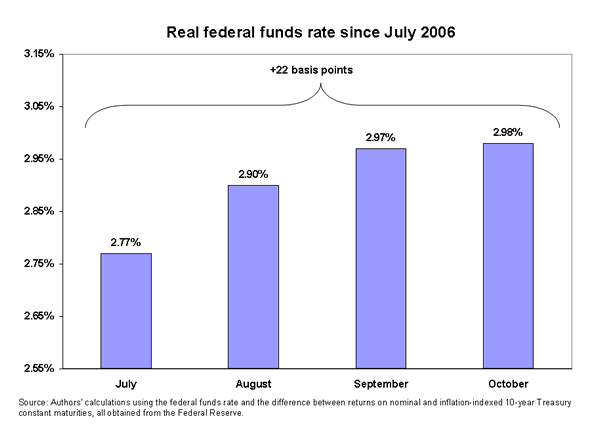See Snapshots Archive.
Snapshot for November 29, 2006.
The Fed needs to move to stay put
by Jared Bernstein and L. Josh Bivens
In the run-up to the December meeting of the Federal Reserve, an important economic policy debate is taking place regarding interest rate policy. Since late June, the Fed has held steady, neither raising nor lowering the federal funds rate (FFR), the key interest rate that sets the cost of borrowing throughout the economy.
Some analysts, noting decelerating growth in GDP, jobs, and inflation, suggest that the Fed should lower the FFR in order to stimulate growth. Others worry that this would create undue inflationary pressure.
What has not been recognized is that recent developments in the economy have actually nudged the real rate of interest significantly higher, threatening to deepen the current slowdown.
The real interest rate is calculated as the nominal rate (FFR) minus the rate of expected inflation. This real rate provides a better measure of the true economic cost of borrowing. When inflation is high, borrowing at a 5% interest rate “costs” less than the same loan when inflation is low, since the money you will pay back in the future has less purchasing power in a higher-inflation economy. The reverse is true when inflation moderates, as it has in recent months—a 5% loan costs more when inflation is low than when it is high.

The Figure shows the real (inflation-adjusted) federal funds rate since July of this year—a period when the Fed has held the nominal rate steady.1 Since then, stability in the nominal rate has masked a 21-basis-point increase in the real rate. To put this in perspective, the last time the Fed raised rates as a matter of policy (on June 28, 2006), it increased rates by 25 basis points. Assuming price growth continues to slow, if the Fed wants to keep the real rate from rising, it needs to consider lowering real rates, and thus reducing nominal rates. In other words, unless the Fed wants to outsource policy making to the whims of the larger economy, it has to move just to stay in the same place.
Note
1. The inflation measure used here is meant to capture long-run expectations about future changes in prices and is quite conservative: the interest rate on nominal 10-year Treasury constant maturities minus the return paid to inflation-indexed 10-year Treasury constant maturities (or TIPS).
